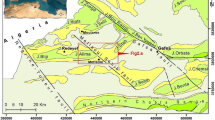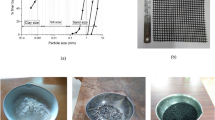Abstract
Liquefaction is one of the most destructive secondary effects caused by large earthquakes, which is most common in saturated soil deposits. In the present study, liquefaction potentials of soils in the southern part of Ahmedabad district of Gujarat state in western India are determined and a liquefaction potential map is prepared. For preparing this map, we studied lithology of the area, geotechnical soil properties, standard penetration resistance (N1)60, ground water level and peak ground acceleration. The liquefaction potential was determined using Japan Road Association method based on standard penetration test (SPT). We analyzed data from 63 boreholes for estimating liquefaction potential. N-value correction for SPT was carried out and normalized to achieve a standardized value of (N1)60. Peak ground acceleration (PGA) levels of 0.19 and 0.30 g are considered for the analysis. The results of the analyses indicate that the presence of predominantly clayey soil with high plasticity does not give high liquefaction. The liquefaction potential index maps are produced which can be used effectively for development plans and risk management practices in this area.








Similar content being viewed by others
References
Ansal A, Tonuk G (2007) Source and site effects for microzonation, Earthquake Geotechnical Engineering. In: Pitilakis K (ed) 4th international conference on earthquake geotechnical engineering-invited lectures, geotechnical geological and earthquake engineering, vol 4, pp 73–92
Biswas SK (1982) Rift basins in western margins of India and their hydrocarbon prospects with special reference to Kutch basin. Am As Petrol Geol 10:1497–1513
Biswas SK (1987) Regional tectonic framework, structure and evolution of the western marginal basin of India. Tectonophysics 135:307–327
Brahmabhatt VS, Yagnik VM, Dave MN and Santwaani PA (2004) Case Histories of Soil Behaviour and Investigations for Seismically Distressed Earthen Dams of Kachchh Region in Gujarat, India. International Conference on Case Histories in Geotechnical Engineering, 39
Castro G (1969) Liquefaction of sands. Harvard soil mechanics series 87. Harvard University, Cambridge
Chu B, Hsu S, Chang Y (2004) Ground behavior and liquefaction analyses in central Taiwan Wufeng. Eng Geol 71(1–2):119–139. https://doi.org/10.1016/S0013-7952(03)00129-7
Committee on Earthquake Engineering (1985) Liquefaction of soils during earthquakes. Commission on engineering and technical system, National academy press, Washington, DC, pp 1–254
Evans MD and Seed HB (1987) Undrained cyclic triaxial testing of gravels: the effect of membrane compliance. Report UCB/EERC-87/08, Earthquake Engineering Research Center, University of California, Berkeley, California
IS 1893-1 (2002) Criteria for earthquake resistant design of structures, part 1: general provisions and buildings [CED 39: Earthquake Engineering], Fifth revision. Bureau of Indian Standards (BIS), pp 4-5
Ishihara K (1984) Post-earthquake failure of a tailings dam due to liquefaction of the pond deposit. In: Proceedings, international conference on case histories in geotechnical engineering, University of Missouri, St. Louis, vol 3, pp 1129–1143
Iwasaki T (1986) Soil liquefaction studies in Japan: state of the art. Soil Dyn Earthq Eng 5(1):1–71
Iwasaki T, Tokida K, Tatsuoka F, Watanabe S, Yasuda S and Sato H (1982) Microzonation for soil liquefaction potential using simplified methods. In: Proceeding of 3rd international conference on microzonation, Seattle, vol 3, pp 1319–1330
Japan Road Association (1980, 1992, and 2002) Specifications for highway bridges, part v earthquake resistant design
Mhaske SY, Choudhury D (2010) GIS-based soil liquefaction susceptibility map of Mumbai city for earthquake events. J Appl Geophys 70(3):216–225. https://doi.org/10.1016/j.jappgeo.2010.01.001
Mohan K, Rastogi BK (2013) Soil modeling, strong motion stimulation and ground response analysis for micro seismic hazard assessment in Gujarat, India. Annual Report, ISR, pp 86–88. www.isr.gov.in
Novikova T, Papadopoulos GA, Karastathis V (2007) Evaluation of ground motion characteristics, effects of local geology and liquefaction susceptibility: the case of Itea, Corinth Gulf (Greece). Nat Hazards 40(3):537–552. https://doi.org/10.1007/s11069-006-9018-9
Rajendran K, Rajendran CP, Thakkar M, Gartia RK (2002) Sand blows from the 2001 Bhuj earthquake reveal clues on past seismicity. Curr Sci 83(5):603–609
Rastogi BK, Gupta HK, Mandal P, Satyanarayana HVS, Kousalya M, Raghavan R, Jain R, Sarma ANS, Kumar N, Satyamurty C (2001) The deadliest stable continental region earthquake occurred near Bhuj on 26th January 2001. J Seismolog 5:609–615
Seed HB, Lee KL (1966) Liquefaction of saturated sands during cyclic loading. J Soil Mech Found Div ASCE 92(SM3):105–134
Seed RB, Stokoe KH (2001) Liquefaction resistance of soils, summary report from the 1996 NCEER and 1998, NCEER/NSF workshop on evaluation of liquefaction resistance of soils. J Geotech Geoenviron Eng ASCE 127(10):817–833
Seyrek E (2003) Liquefaction problem in foundation soil of earthfill dam and a case study, M.Sc. thesis, Graduate School of Natural and Applied Sciences, Eskisehir Osmangazi University, Eskisehir
Tosun H, Seyrek E, Orhan A, Savas H, Turkoz M (2011) Soil liquefaction potential in Eskisehir, NW Turkey. Nat Hazards Earth Syst Sci 11:1071–1082. https://doi.org/10.5194/nhess-11-1071
Youd TL, Hoose SN (1977) Liquefaction susceptibility and geologic setting. In: Proceedings, 6th world conference on earthquake engineering, New Delhi, vol 3, pp 2189–2194
Youd TL, Perkins DM (1978) Mapping liquefaction-induced ground failure potential. J Geotech Eng Div 104:443–446
Acknowledgements
We are thankful to Mr. Fumio Kaneko of Oyo International Corporation, Japan, for his kind guidance and preparation of some figures. The study was funded by Gujarat Infrastructure Development Board and GICCL. Authors are grateful to Dr. M. Ravi Kumar, Director General, ISR, for his kind permission to publish the work and Dr. Sumer Chopra, Director for his support. We are thankful to Prof J. R. Kayal for critically going through the manuscript.
Author information
Authors and Affiliations
Corresponding author
Rights and permissions
About this article
Cite this article
Thokchom, S., Pancholi, V., Rastogi, B.K. et al. Liquefaction potential mapping in Dholera region of western India. Nat Hazards 92, 479–495 (2018). https://doi.org/10.1007/s11069-018-3214-2
Received:
Accepted:
Published:
Issue Date:
DOI: https://doi.org/10.1007/s11069-018-3214-2




